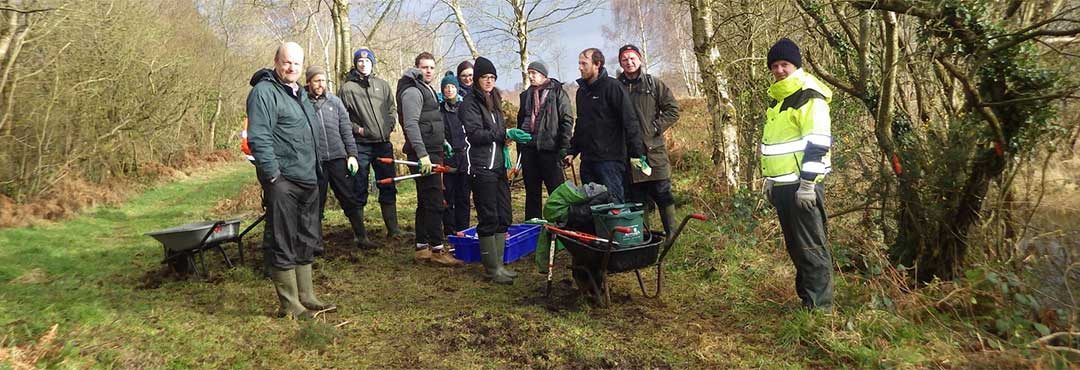Latin name: Sciurus vulgaris
Family: Sciuridae
Description of the Red Squirrel
Squirrels are easily recognised by their distinctive body shape and bushy tail. The red squirrel is a smaller and more delicate animal than the grey squirrel. Coat colour varies in both species and can cause some confusion in identification. Red squirrels are generally brown, but the shade can range from chestnut right through to grey-brown. The belly fur is white. During the summer, the tail fur fades to a pale cream colour and the ear tufts are more or less absent. In winter, the body and tail fur is thick and dense and the red squirrel’s long dark ear tufts are very noticeable. Grey squirrels do not have ear tufts. There is little difference between males and females, which makes it difficult to distinguish between the sexes.
Squirrels are active during the day. Red squirrels are more likely to be seen high up in the tree canopy, while grey squirrels are often seen feeding on the ground.
They make a ‘chuk chuk’ noise when agitated and tap branches with their feet. If they are frightened, they’ve probably already disappeared!
Size
Length: 180-244 mm and tail about 180 mm
Weight: adult red squirrels 280-350g (greys 500-600g)
Historical Info
The red squirrel is believed to have been present in Ireland since the end of the last Ice Age. During the 1700s it is thought to have become extinct in Ireland; whether this was due to disease, hunting or loss of habitat is not known. During the early 1800s, red squirrels were reintroduced to Ireland from Britain and by the early 1900s were present in all counties in Ireland, both north and south. The population continued to increase for a short time, then began to decline rapidly across the British Isles.
The Red Squirrel’s Habitat
Red squirrels live in large patches of conifer forest (over 50 hectares) and, in the UK, have adapted to Scots pine forest. They can be found at altitudes up to 2000m in the Alps and Pyrenees.
Red squirrels build large nests, called dreys, often in the forks of tree trunks. They are usually solitary, only coming together to mate, but they do not mind social interactions and related squirrels will share dreys to keep warm during cold winter months. Reds range widely, especially when looking for mates.
Diet
Red Squirrels are seed eaters. They favour pine cones, but also eat larch and spruce. Their diet also includes fungi, shoots and fruits of shrubs and trees, and sometimes bird’s eggs. They can choose between ‘good’ and ‘bad’ nuts (those full or empty) by holding them in their paws. Reds do not hibernate and often store food in trees to eat over the winter months. When food is plentiful, they put on weight in the autumn to help them through the winter. This is important for breeding females, so that they are in good condition for producing young.
Threats to the Red Squirrel
Although not thought to be under any threat worldwide, the Red Squirrel has drastically reduced in number in the United Kingdom in the last fifty years. Fewer than 140,000 individuals are thought to be left, approximately 85% of which are in Scotland.
It is thought this reduction is due to fragmentation of native woodland habitats, disease (squirrel parapox virus), lack of tree seed food and, in some areas, road casualties – but by far the greatest threat to the native Red Squirrels is competition from the non-native Grey Squirrel. Greys can feed more efficiently in broadleaved woodlands and can survive at densities of up to 8 per hectare. The density of reds is up to 1 per hectare in broadleaved woodland but can be as low as 0.1 per hectare in coniferous woodland.
Outside the UK and Ireland, the threat from the eastern grey squirrel comes from a population in Piedmont, Italy, where two pairs escaped from captivity in 1948. A significant drop in red squirrel populations in the area has been observed since 1970, and it is feared that the eastern grey squirrel may expand into the rest of Europe.
Grey squirrels seem to be better adapted to live in deciduous woodland and it appears that they are able to out-compete the red squirrel for various reasons:
The grey squirrel can easily digest acorns, while the red squirrel cannot.
The grey squirrel carries and spreads a disease, the squirrel parapox virus that does not appear to affect their health but will often kill the red squirrel.
When the red squirrel is put under pressure, it will not breed as often.
It is worth noting that the grey squirrel and the red squirrel are not directly antagonistic towards each other, and direct violent conflict between these species is not a factor in the decline in red squirrel populations.

